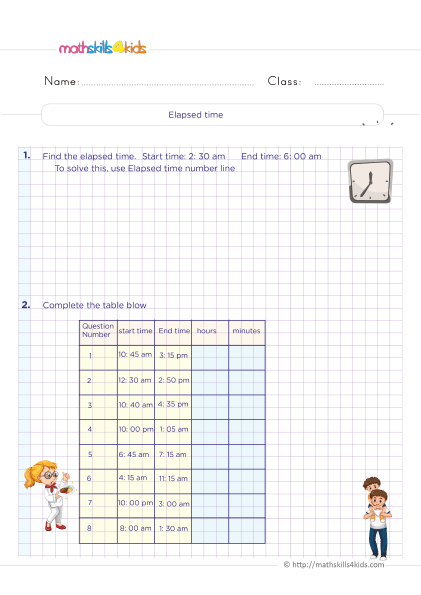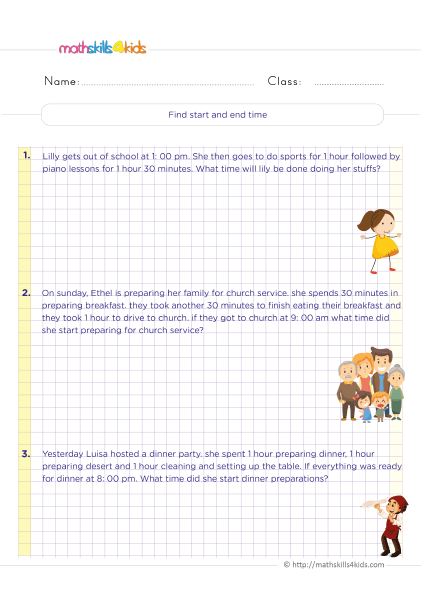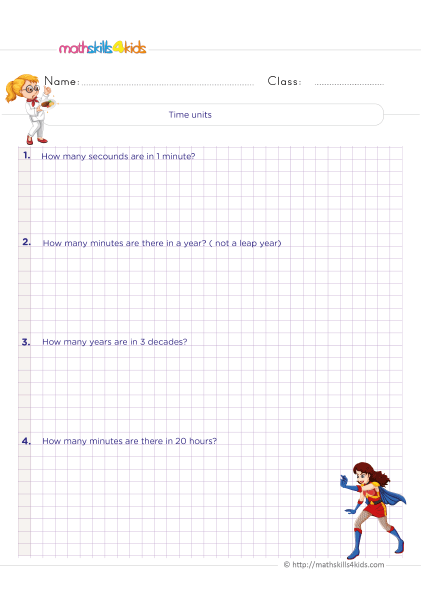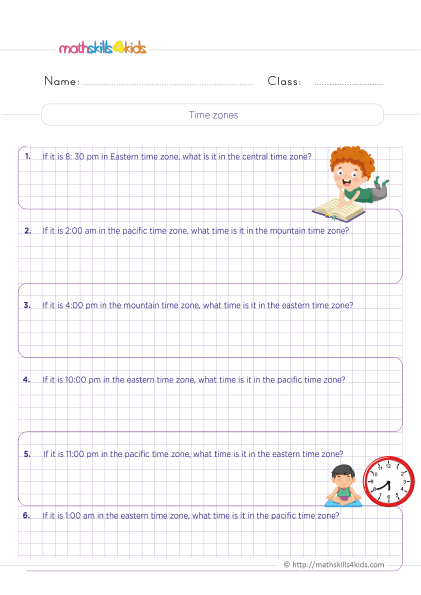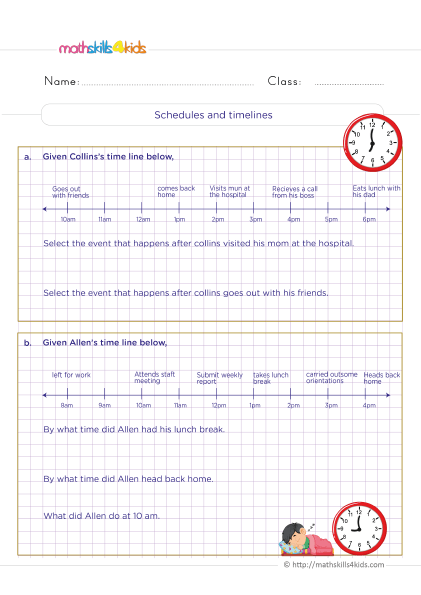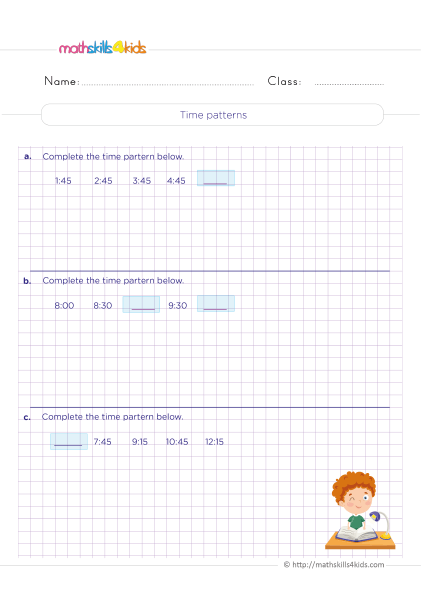Time for Fun: 6th Graders measuring and telling time worksheets
Hello everyone. It's another time for fun with our fascinating math article! Today, we will discuss a very important topic for 6th graders: time. Time is an important life skill that measures the duration of an event. In this article, you will find various 6th Graders measuring and telling time worksheets designed to make time learning fun and engaging for students.
-
In junior grades, most kids tend to calculate time just for fun, but as they move to higher grades, they’ll begin to realize that without time management skills, they’ll become failures in life.
Thus, with the help of Mathskills4kid’s measuring and telling time worksheets, your 6th Grade students will learn how to calculate elapsed time and convert time units like pros.
How to calculate elapsed time and convert time can improve 6th-graders' time skills.
As earlier said, we use time daily, but does your 6th grader know how to calculate elapsed time and convert time units? Not to worry. This article will uplift your 6th-graders' time skills, and they’ll become great critical thinkers and problem solvers.
The concept of time is an essential skill that can help 6th graders in many situations, such as planning the day, scheduling appointments, traveling, cooking, etc.
This article will explain elapsed time and time conversion, how to use different methods to find them, and how to solve word problems involving elapsed time.
We will also share some fun activities and games students can do at home or in the classroom to practice their time skills. Are you ready? Let's get started!
-
BROWSE THE WEBSITE
-
DOWNLOAD FREE WORKSHEETS
-
-
GRADE 6 MATH TOPICS
- Whole numbers
- Multiplication
- Division
- Exponents and square roots
- Number theory
- Decimals
- Add & subtract decimals
- Multiply & divide decimals
- Fractions & mixed numbers
- Add & subtract fractions
- Multiply fractions
- Divide fractions
- Integers
- Operations with integers
- Mixed operations
- Rational numbers
- Problems solving
- Ratio & proportions
- Percentages
- Measuring units
- Money math
- Consumer math
- Telling time
- Coordinate graph
- Algebraic expressions
- One step equations
- Solve & graph inequalities
- Two-step equations
- 2D Geometry
- Symmetry & transformation
- 3D Shapes
- Geometry measurement
- Data and Graphs
- Statistics
- Probability
-
Buying is supporting us!
Buy Now...
-
-
Why time matters for 6th graders
Time is one of the most essential concepts in math and life, so it matters a lot for 6th graders. As kids grow older, they must learn to manage their time more effectively and efficiently. They will have more responsibilities like homework, projects, chores, hobbies, and social activities.
They will also have more opportunities, such as traveling, learning new things, and exploring new interests. Given this, they need to know how to calculate elapsed time and convert time units to maximize their time. These skills will help them organize their schedule, plan, set goals, and achieve them.
-
What is elapsed time, and why is it important?
Elapsed time is the time that passes between two events or points in time. For example, if you start reading a book at 9:00 a.m. and finish it at 10:30 a.m., the elapsed time is 1 hour and 30 minutes. Elapsed time is important because it helps us measure how long something takes or lasts.
We can use elapsed time to estimate how much time is needed to complete a task, how much time is left to finish something, or how much time has passed since something happened.
-
How to use a number line to find elapsed time
One way to find elapsed time is to use a number line. A number line is a line that shows numbers in order from left to right. We can use a number line to represent hours, minutes, or seconds. To find elapsed time using a number line, follow these steps:
- Draw a number line and label it with the start time and the end time of the event.
- Mark the start time with an arrow pointing to the right.
- Mark the end time with an arrow pointing to the left.
- Count the number of units between the two arrows. This is the elapsed time.
For example, suppose you want to find the elapsed time between 7:15 a.m. and 8:45 a.m. You can draw a number line like this:

The elapsed time is the number of units between the two arrows. Each unit represents 15 minutes. There are six units between the arrows, so the elapsed time is 6 x 15 = 90 minutes.
-
How to use a T-chart to find elapsed time
Another way to find elapsed time is to use a T-chart. A T-chart is a table that has two columns and several rows. We can use a T-chart to break down the start and end times into hours and minutes. To find elapsed time using a T-chart, we can follow these steps:
- Draw a T-chart and label the columns "Hours" and "Minutes."
- Write the start time in the first row of the T-chart.
- Write the end time in the second row of the T-chart.
- Subtract the hours in the first row from those in the second row. Write the result in the third row under "Hours."
- Subtract the minutes in the first row from those in the second row. If we get a negative number, we can borrow an hour from the "Hours" column and add 60 minutes to it. Write the result in the third row under "Minutes."
- The elapsed time is the sum of the hours and minutes in the third row.
For example, suppose we want to find the elapsed time between 3:40 p.m. and 5:25 p.m. We can draw a T-chart like this:
Hours
Minutes
3
40
5
25
-
-
2
-15
To get rid of the negative sign in the "Minutes" column, borrow an hour from the "Hours" column and add 60 minutes to it. The T-chart becomes:
Hours
Minutes
3
40
5
25
-
-
1
45
The elapsed time is the sum of the hours and minutes in the third row, which is 1 hour and 45 minutes.
-
How to convert time units using multiplication and division
Sometimes, we may need to convert time units from one to another. For example, students may need to convert hours to minutes, minutes to seconds, or vice versa. To convert time units using multiplication and division, follow these rules:
- To convert a larger unit to a smaller unit, multiply by the number of smaller units in one larger unit.
- To convert a smaller unit to a larger unit, divide by the number of smaller units in one larger unit.
For example, suppose we want to convert 3 hours to minutes. We can multiply by the number of minutes in one hour, which is 60. The result is 3 x 60 = 180 minutes.
Suppose we want to convert 120 seconds to minutes. We can divide by the number of seconds in one minute, which is 60. The result is 120 / 60 = 2 minutes.
-
How to solve word problems involving elapsed time and time conversion
Word problems are problems that use words to describe a situation that involves math. To solve word problems involving elapsed time and time conversion, follow these steps:
- Read the problem carefully and identify what is given and what is asked.
- Choose a method to find elapsed time or convert time units, such as a number line, a T-chart, or multiplication and division.
- Apply the method and show the solution.
- Write the answer in a complete sentence and check if it makes sense.
For example, suppose we have this word problem:
Anna started baking a cake at 2:15 p.m. She took it out of the oven at 3:05 p.m. How long did it take her to bake the cake?
To solve this problem, we can use a T-chart to find elapsed time. The problem gives us the start time and the end time of the event. The problem asks us how long it took Anna to bake the cake. We can draw a T-chart like this:
Hours
Minutes
2
15
3
05
-
-
1
-10
To get rid of the negative sign in the "Minutes" column, borrow an hour from the "Hours" column and add 60 minutes to it. The T-chart becomes:
Hours
Minutes
2
15
3
05
-
-
0
50
The elapsed time is the sum of the hours and minutes in the third row, which is 0 hours and 50 minutes. We can write the answer in a complete sentence like this:
It took Anna 50 minutes to bake the cake.
-
Fun activities and games to practice elapsed time and time conversion skills
Now that your 6th Grade students know how to calculate elapsed time and convert time units, they can practice their skills with fun activities and games. Here are some ideas:
- Time Bingo: Create bingo cards with different time expressions, such as 3 hours and 15 minutes, 7:45 p.m., or half past nine. Call out a time expression and have the students mark the matching one on their cards. The first one to get a bingo wins.
- Time Scavenger Hunt: Hide clues around the classroom or the school that have time-related questions or tasks, such as “What time is it right now?”, “How long does it take to walk from the library to the cafeteria?” or “Convert 150 minutes into hours and minutes.” Have the students work in teams to find and solve the clues. The team that finishes first or with the most correct answers wins.
- Time Jeopardy: Create a Jeopardy board with categories such as Elapsed Time, Time Conversion, Word Problems, and Fun Facts. Have the students work in teams to choose a category and a point value and answer the corresponding question. The team with the most points at the end wins.
- Time Capsule: Have the students create a time capsule with items representing their interests, hobbies, goals, and dreams. Have them write a letter to their future selves, describing what they are like now and what they hope to achieve. Seal the time capsule and set a date to open it, such as in a year or at the end of 6th grade.
Bonus: Where to find more resources with fun 6th graders measuring and time-telling worksheets and activities
If you and your 6th-graders are looking for more resources with fun 6th-graders measuring and time-telling worksheets and activities, here are some web links with descriptions of online games and activities that you can try:
- Time Zone X: This game tests your students' knowledge of world time zones and geography. They will answer questions about what time it is in different places worldwide and how to convert between different time units. They can choose from three difficulty levels and earn badges as they progress. https://www.brainpop.com/games/timezonex/
- Elapsed Time Calculator: This tool helps 6th graders find the elapsed time between two given times or the start or end time given the elapsed time. They can also show the calculation steps and use a number line or a T-chart to visualize the problem. https://www.calculator.net/time-duration-calculator.html
- Time Worksheets: This website offers a variety of printable worksheets for practicing elapsed time and time conversion skills. You can customize the worksheets by choosing the number of problems, the time intervals, the units, and the difficulty level. You can also generate answer keys for checking students’ work. https://www.math-aids.com/Time/
- Telling Time Basketball Game: This game lets 6th graders practice telling time using analog and digital clocks. They will match the time on the clock with the correct option and shoot the ball into the basket. They can choose from four difficulty levels and play against the computer or a friend. https://www.futuristicmath.com/basketball-games/telling-time-to-the-hour.html
- Time Riddles: This activity challenges students to solve riddles involving elapsed time and time conversion. They will read the clues and use their logical thinking skills to find the answer. They can also check their answers and see the explanations. https://hobbylark.com/puzzles/riddles-about-time
-
-
Thank you for sharing the links of MathSkills4Kids.com with your loved ones. Your choice is greatly appreciated.
Conclusion
Learning how to calculate elapsed time and convert time units is essential for 6th-graders, as it helps them develop their mathematical reasoning, problem-solving, and time management skills. With strategies such as number lines, T-charts, multiplication, and division, students can easily find elapsed time and convert time units.
Also, by practicing these skills through fun activities and games, students can improve their motivation, engagement, and confidence in learning time. We hope you enjoyed this article and found it useful for your 6th-graders.
Happy learning!
